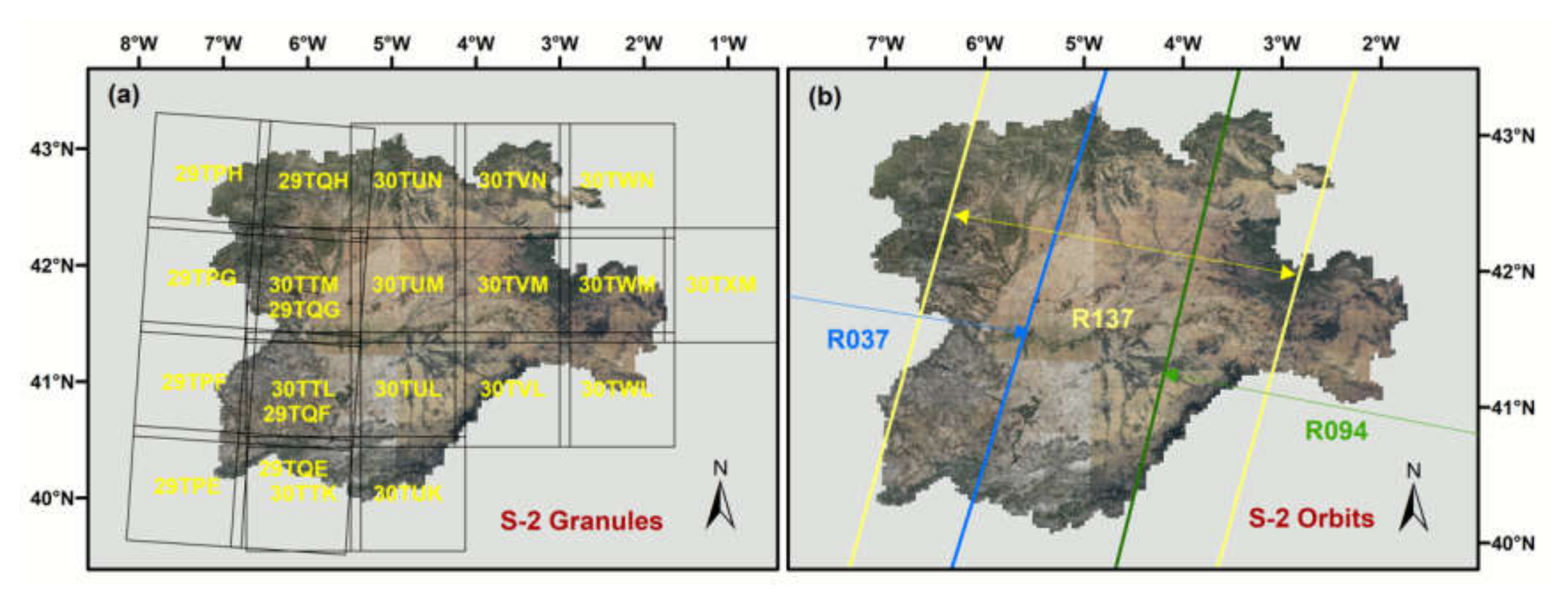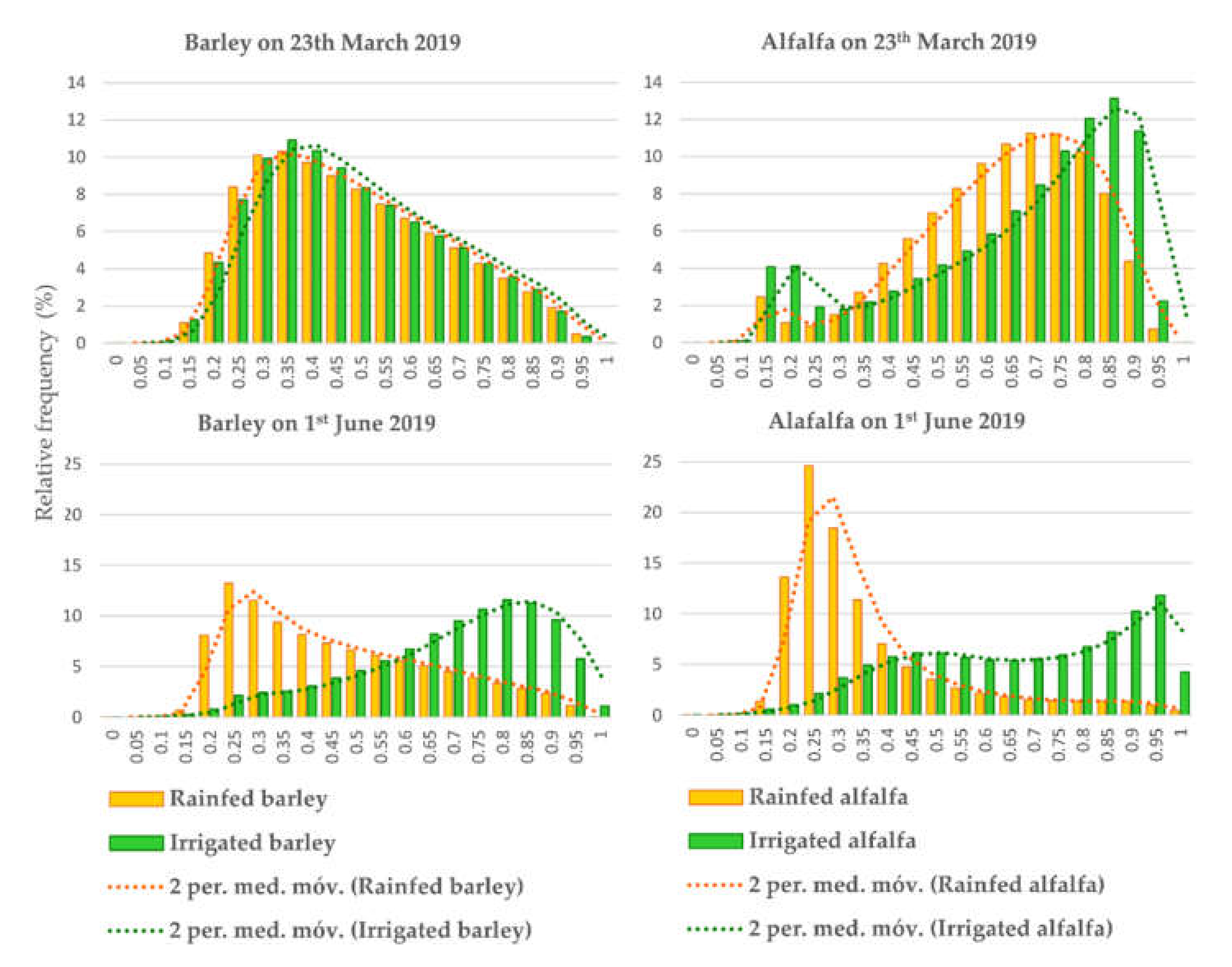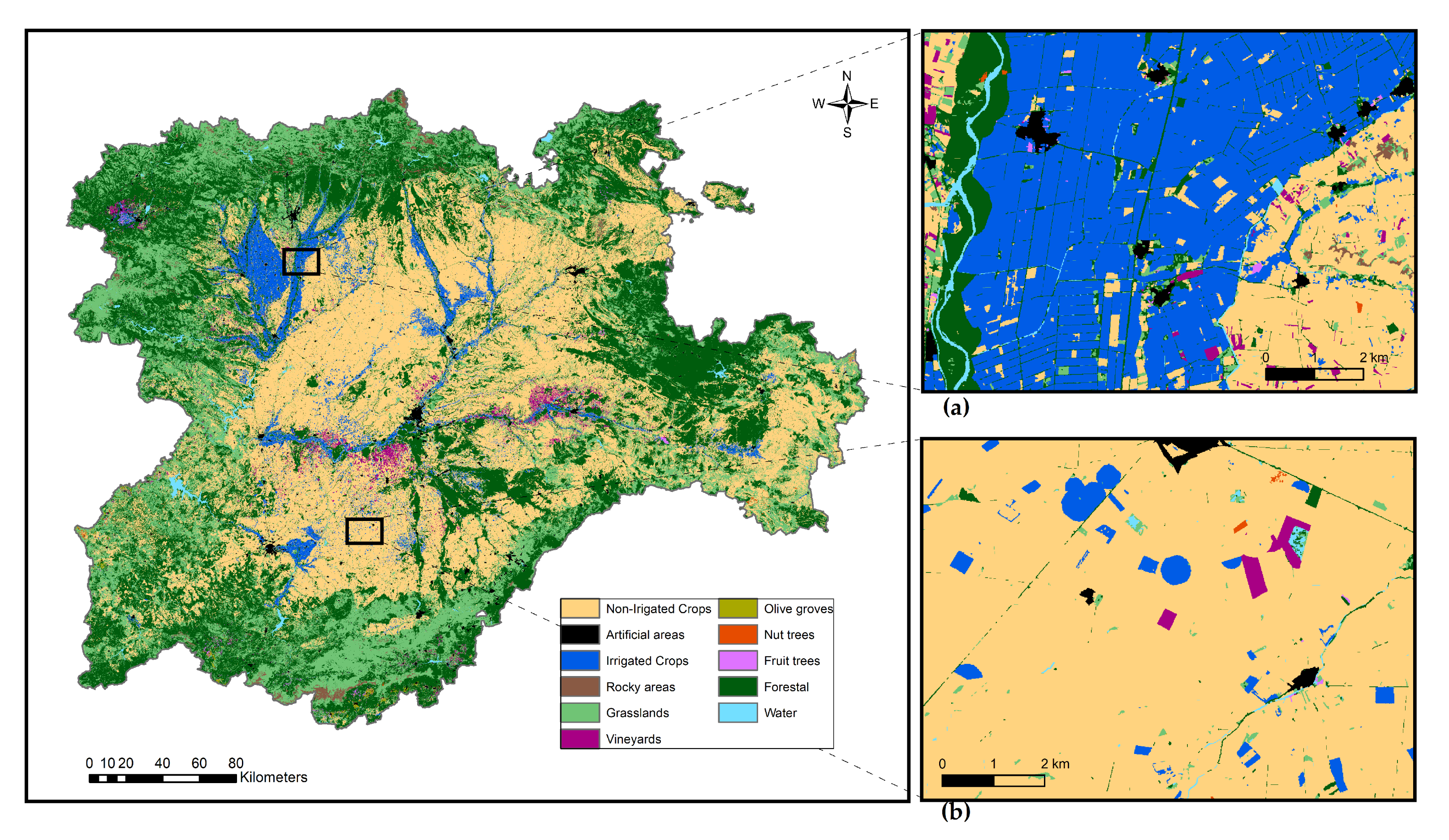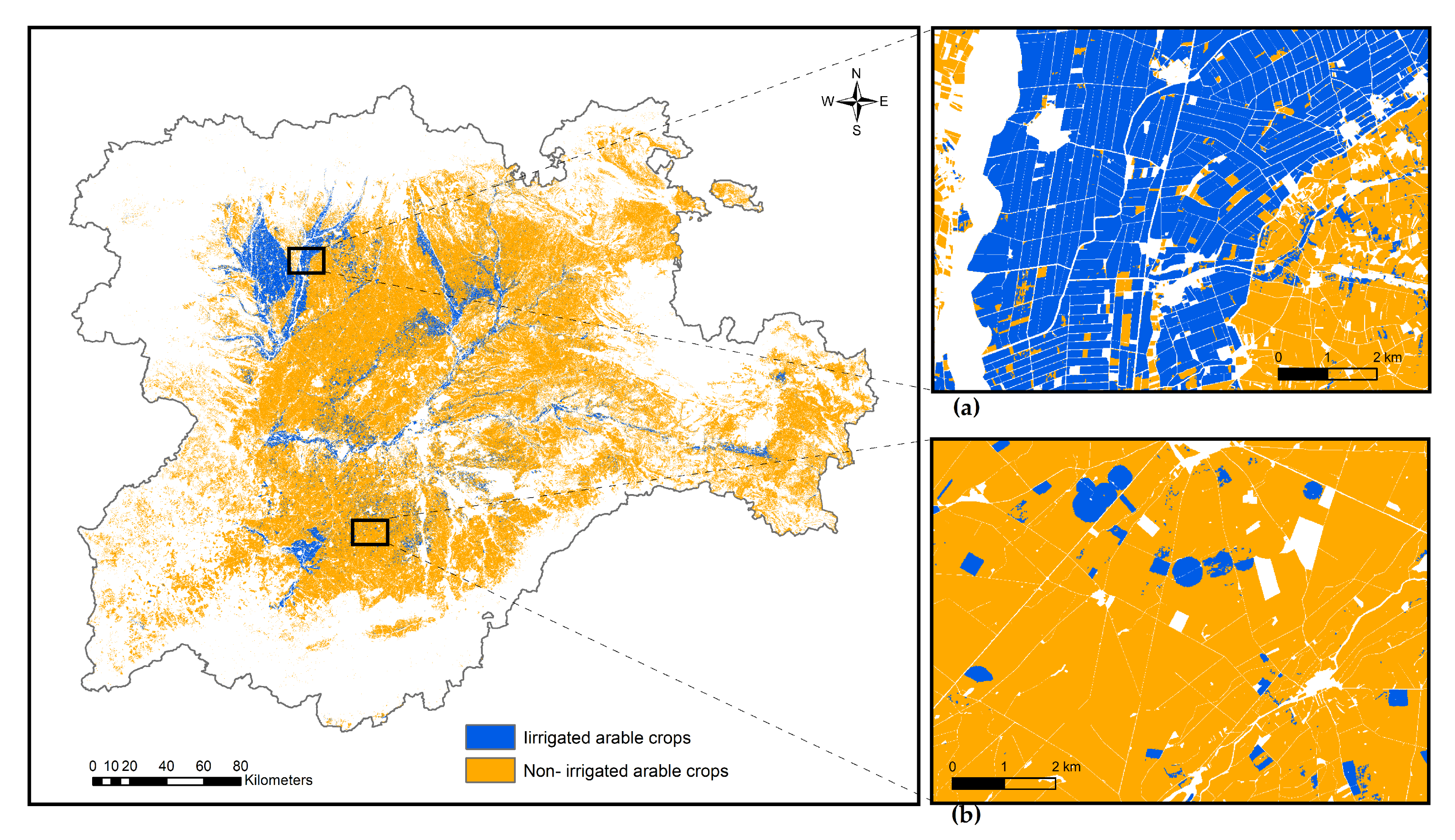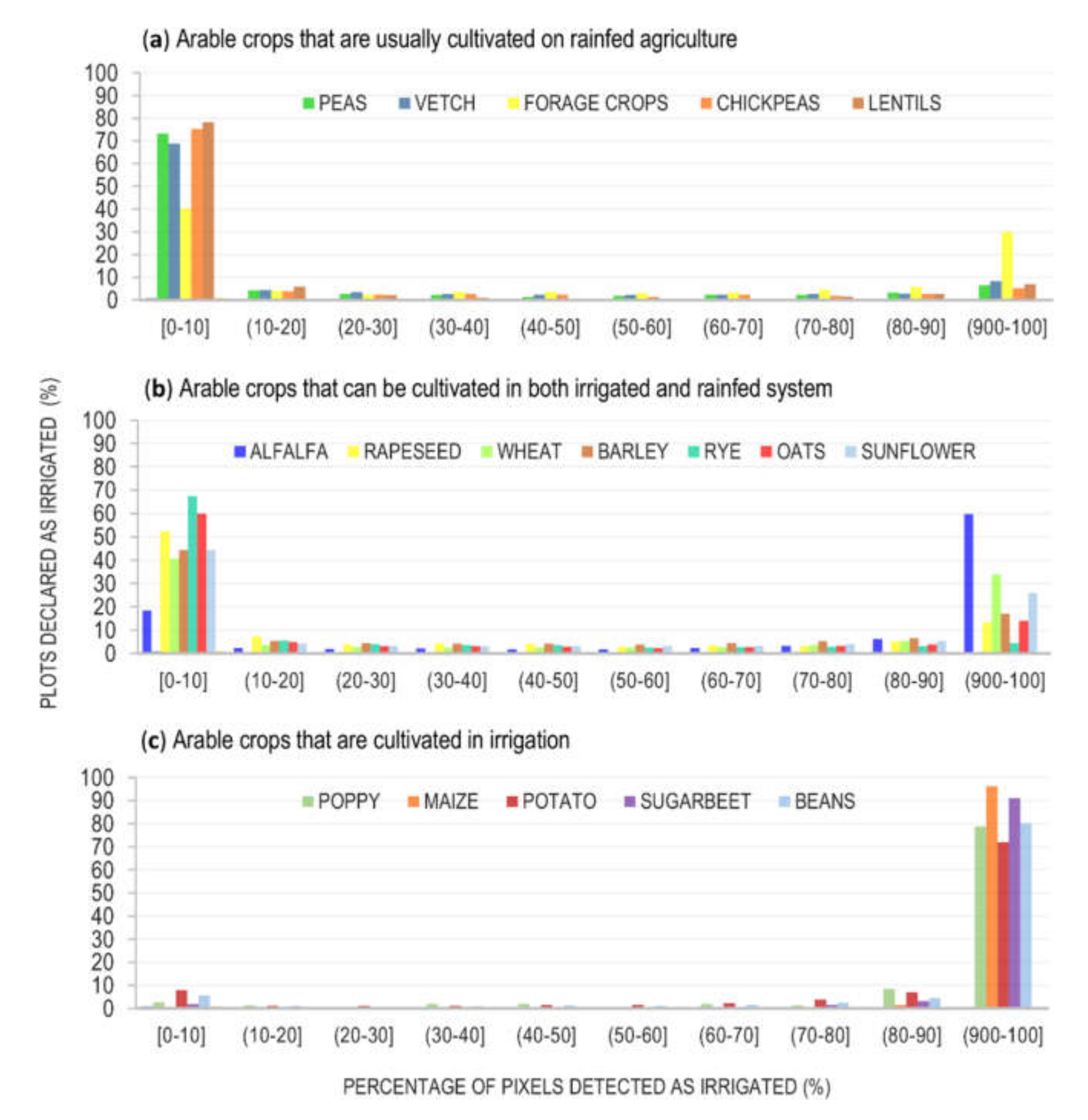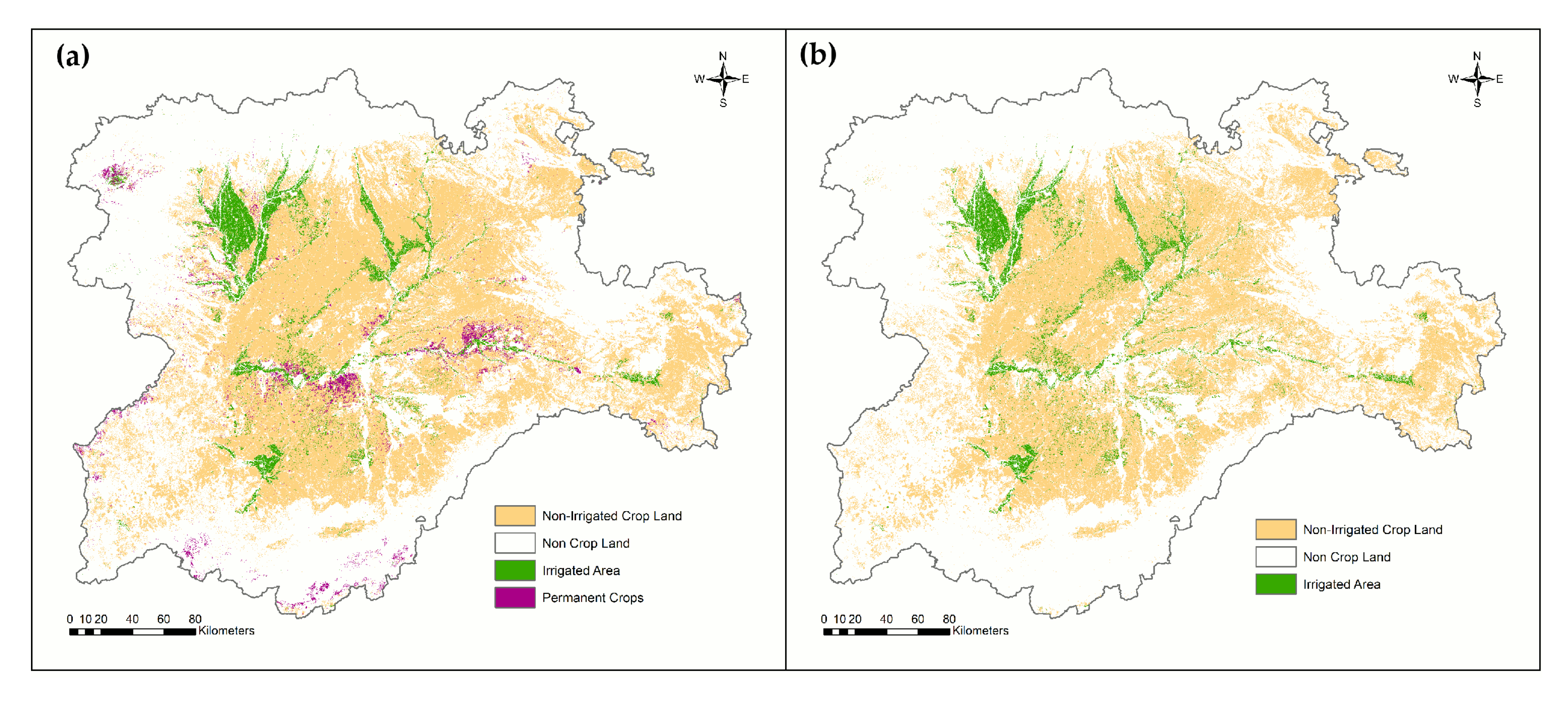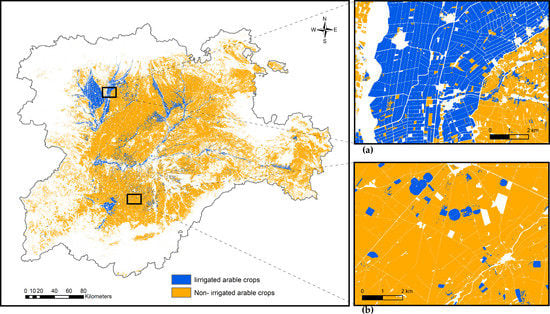1. Introduction
As of 22 May 2018, the European Commission (EC) adopted new rules [
1] as a movement to simplify and modernize the EU’s Common Agricultural Policy (CAP) allowing for the first time the usage of a range of modern technologies when carrying out checks for CAP payments. Particularly, these new rules enable data from the EU’s Copernicus Sentinel satellites and other Earth Observation (EO) platforms to be used as evidence when checking farmers’ fulfillment of requirements under the CAP for area-based payments, either direct payments to farmers from European agricultural guarantee fund (first pillar of the CAP) or rural development support payments (second pillar of the CAP). This includes the possibility to completely replace physical checks on farms, the so-called on-the-spot Check (OTSC), with an automatic-check system based on EO data analysis. It is worth noting that this OTSC system only checks 5% of the dossiers randomly selected from the whole of applicants, either with field visits or computer-aided photointerpretation (CAPI). Opposite to this resource and budget consuming procedure is the capability of monitoring almost 100% of the dossiers by means of what have been called Checks by Monitoring (CbM). This new procedure not only should support the control of those area-based payments but also the cross-compliance requirements, which set environmental and other commitments that farmers must address to receive subsidies. The new CAP paradigm requires the competent authorities, member state, or paying agency (PA), to develop a system to gradually substitute the current OTSC system with the new control by monitoring procedure by phase-in CbM. This transition period or phase-in period should be limited in time to ensure equal treatment of beneficiaries [
1].
In this context, the PA of Castile and León (Spain) has been involved since the very beginning of the setting out of the new CAP monitoring approach, in 2018. Therefore, a new system of controls has been set to be applied to the main aid lines from the first pillar of the CAP in which irrigation is not a determining factor, such as basic payment subsidies (BPS) and its derivates, Young Farmers Scheme, Greening, and all Voluntary Coupled Support schemes. In all, it addressed eight first pillar schemes in 2019. This meant that in Castile and Leon over 5000 holdings covering almost 340,000 ha were checked by monitoring, which turned out that more than 63 million euros were paid to farmers in the phase-in area thanks to CbM. This first experiment was large enough to draw conclusions for next year.
Among other products and strategies, one of the key base information layers on which this system relies on is the Castile and Leon crops and natural land map (MCSNCyL, Spanish acronym) which is a land cover layer, updated twice a year, at the middle of the agricultural campaign, in July, and, at the end of the campaign, in October [
2]. The project began in 2013, and since then, layers have been generated annually from 2011 to 2019. From 2017 on, this regional land cover map is generated with 10 m ground sampling distance (GSD) spatial resolution, thanks to the pair of satellites S-2A and S-2B of the constellation Sentinel within the Copernicus program. This spatial resolution is optimal for agricultural land monitoring since it has been reported that fine spatial resolutions of 10–30 m are ideal for regional-scale monitoring purposes [
3]. Recently, there have been several studies proving its good performance of using Integrated Administrative Control System (IACS) data for crop type mapping [
4]. There are other sources to extract the crop type information, such as the global ESA-CCI Land Cover product which distinguishes irrigated cropland or post-flooding areas [
5]. Unfortunately, their spatial resolution is far from being convenient for this purpose since its spatial resolution of 300 m GSD is so coarse that it is ineffective for agricultural monitoring at parcel level. Using the ESA-CCI crop map to identify irrigation, most of the plots smaller than 9 ha would be ignored, which account for over 95% of all agricultural plots in Castile and León, where the average plot is 2.4 ha. Other global irrigation datasets are the United Nations Food and Agricultural Organization (FAO) and Rheinische Friedrich–Wilhelms–University deriving Global Map of Irrigation Areas version 5 [
6] with a spatial resolution of 7 km in this area, and the Global Irrigated Areas Mapping from Institute Water Management Institute (IWMI) at 750 m spatial resolution [
7].
In contrast, the MCSNCyL can detect plots greater than 0.01 ha, thus most of the plots in the region can be identified. The overall accuracy achieved and that obtained in each crop category considered in this crop map [
8] were highly acceptable and enables it to be used in the crop identification to determine whether the declared crop was reliable or not. This has been demonstrated after the first experience using CbM in the region over the phase-in area. As an extra validation process, field visits were carried out to verify the grade of reliability and the result was also successful (not shown here) and proved that this regional crop map met some of the basic requirements for the CAP control system, such as crop type identification, agricultural activity control or crop diversification assessment.
However, following the EC regulations regards to phase-in period [
1] the aids control system in Castile and León should gradually keep on developing towards the control aids in the second pillar of the CAP (rural development policy). This type of aids implies the need to establish a system that allows determining if the plots are actually irrigated since some of these lines establish limitations in relation to the use of water. In addition, the cross-compliance of the CAP (a set of basic rules that farmers must respect in order to receive EU income support), which until now has not been subject to monitoring controls, also implies that irrigation should be carried out only in plots that have rights to do so. Cross-compliance fulfillment control is expected to be addressed also in the near future. Thus, any support offered to the decision-making system in terms of irrigation identification is going to be an essential part of the Area Monitoring System with the current regulation and especially with the new CAP post-2020.
Thus, under this background, it is necessary to study and assess different methodological approaches to offer a product that distinguishes irrigated plots from the non-irrigated ones. To achieve this objective, in this study two strategies are presented, assessed, and discussed in order to offer a solution in the first place to our own PA, and in second place to the rest of the interested community, other PAs, and stakeholders.
The importance of the implementation of a methodology to detect irrigated crops also lies in the current limitation of knowing the cropland area actually irrigated [
9], as well as its annual variation, particularly with regards to herbaceous or arable crops. Based on our experience in CAP controls, the data recorded in the farmers’ aid application forms are related mainly to the possibility to irrigate that parcel, regardless of the actual regimen of the current crop in the plot. For this reason, the study presented here provides information of great interest not only for the future CbM, but also for irrigation planning and modernization, crop yield statistics, and water management. The irrigated area estimation and identification of irrigated crops have been the subject of numerous research works [
10,
11,
12] precisely because of the importance of having as much knowledge as possible of the use of water in an increasingly water-scarce world. Therefore, the ultimate goal to be achieved is to have a better understanding of the use of water for agriculture in our region and thus be able to achieve the objectives proposed by the European guidelines for more efficient agriculture and sustainable water resources.
Given the relevance of this issue, in the last decade, several studies have addressed this issue and have proposed different methodologies to map and monitoring irrigated areas using remote sensing data. Ambika et al. (2016) [
11] developed annual irrigated area maps at a spatial resolution of 250 m for the period of 2000–2015 in India using the normalized difference vegetation index (NDVI) data from the moderate resolution imaging spectroradiometer (MODIS). Vogels et al. (2019) [
13] proposed a methodology with a semi-automatic classification using image segmentation and variables such as shape, texture, neighbor, and location apart from commonly used spectral variables obtaining excellent results over a small area (669 km
2), but requiring visual interpretation to label the training and validation dataset. The extent of our study area is 140 times larger than that, and visual interpretation is not feasible for operational classification over such a large area. More recently, there has been a plethora of works addressing this issue [
13,
14,
15,
16,
17]. A special interest has been focusing on radar data, especially on Sentinel-1 or the synergy between Sentinel-1 and Sentinel-2 to propose more methodological approaches to detect irrigated areas [
15,
16,
17].
However, what the checks by monitoring require is a methodology to assess the regular or continuous irrigation on a certain plot, or the probability of having been watered at some point during the development of the crop, by means of an automatic classification without any visual interpretation, since the vast extension we need to address it would be a very time-consuming data preparation process. Timing is a key point to consider if we want to check farmer’s applications on the ongoing agricultural campaign. Besides, the average size of an agricultural plot in Castile and León is about 2.4 ha, thus we need a resulting map with a fine spatial resolution over 20 m GSD to have a minimum quantity of pixels per plot, which also allows us to know its intra-parcel variability to let us detect no irrigation, homogeneous irrigation, or occasional irrigation.
Considering the above, in 2019 it was carried out a work to investigate if the traditional methodology employed to elaborate annually the MCSNCyL was also suitable to detect herbaceous irrigated crops. This research gave, as a result, a work presented in the Congress of the Spanish Association of Remote Sensing in 2019 [
18]. In this work, the performance of the MCSNCyL approach for detecting irrigated agriculture was assessed obtaining very satisfactory accuracies. As examples, the ranges of F-score values obtained in the four irrigated crops with the most dedicated area in Castilla y León were (96.8–98.2), (62.7–77.8), (76.7–84.9), and (92.3–94.9), for maize, irrigated wheat, irrigated alfalfa, and sugar beet, respectively, during 2016, 2017, and 2018. Thus, it was proved that our method based on a decision tree algorithm and IACS data as reference data gave very accurate results for detecting irrigated agriculture over a national-scale area and even considering more than one hundred of land cover classes. It is reasonable to presume that, if the number of classes detected was decreased or the study area was smaller, the accuracy measures would be even higher. We also researched this assumption in 2019, but the results were never disseminated. That year, the CAP monitoring system designed in Castile and León was expected to check farmer’s applications in a phase-in area covering 8239 km
2, because our region was one of the 15 regions committed to carrying out the checks by monitoring from 2019 onwards. Thus, the same classification method was applied in the phase-in area, but only addressing 37 classes in order to improve the final accuracy. The overall accuracy and kappa index obtained were 94.60% and 0.93, respectively, in the phase-in area. Therefore, the MCSNCyL methodology with a reduced number of classes could meet the need for detecting irrigated cropland in order to support the checks by monitoring. However, this new approach of the traditional methodology would have a constrain regards to the minority crops that are not represented within the 37 classes directly derived from MCSNCyL 2019, and so, they will not be detected as irrigated, if necessary. That was the starting point to consider that it would be more convenient to get a binary classification map, where there were not land cover classes, but rather a pixel identification as irrigated or rainfed. That way, it would be possible to detect irrigated pixels in any land cover if full or partial watering had been applied. Ambika et al. (2016) [
11] derived irrigated area maps according to agroecological zones using the NDVI threshold with satisfactory accuracies since Ozdogan, et al. (2008) [
10] previously had demonstrated that the NDVI threshold approach was promising for identifying irrigated areas. Therefore, we consider including in the methodology a variable determining different agroclimatic areas in order to consider that crops show phenological differences depending on which agroclimatic area they are developed. We also include in both approaches the NDVI images on certain key dates.
Therefore, the main aim of this study is to present a new variant derived from the MCSNCyL methodology to obtain the regional crop map [
18] which provides us with irrigated binary maps. This new approach uses the same classifier, reference data, and satellite images. The difference between them is the ancillary data and the classes definition. The reference data for irrigated crop maps will require to reclass the very detailed legend with more than one hundred classes to just two: irrigated or not irrigated class. The comparison of the results of the two variants of the same methodology (a land cover map of 121 classes versus a binary irrigation map) to detect irrigated crops in Castile and León will be analyzed to determine which one is more convenient to be implemented in the checks by monitoring in the phase-in area of Castile and Leon. Besides, a detailed implementation methodology to include the irrigated binary maps results into the CAP monitoring system will be described in order to let it be operational in this ongoing year 2020.
4. Discussion
Both irrigation maps derived from the two procedures applied in this work have yielded similar results, not only regarding the accuracy measures but also in the allocations of the irrigated areas. Most of the irrigated plots detected are concentrated in the well-known irrigable areas in Castile and Leon (
Figure 4 and
Figure 5). Nevertheless, we can also detect, in both strategies, some rainfed fields within the irrigation areas, and on the contrary, we can detect sparse irrigation plots in the predominantly rainfed area (
Figure 4 and
Figure 5).
It is important to bear in mind that summer crops in irrigation agriculture are easier to identify due to the agroclimatic conditions existing in our region, given that crops such as corn, beet, and potato, among the most representative, are only cultivated in that season under irrigation. However, discriminating winter crops that can take place in both systems of cropping systems (irrigation and rainfed agriculture) is the real challenge, since the difference in spectral response between the two systems in spring is not as pronounced as in summer when water stress conditions cause rainfed crops to react to such stress [
28]. For that reason, from the remote sensing approach, solving this situation is complicated. However, the methodology proposed has been effective for this purpose, as it can be seen in
Table A1, which shows the discrimination of the irrigation system in the most representative winter crops in the community of Castile and León, for instance, wheat which represents approximately 11% of the total area of the region (see
Appendix A Table A2).
The discrimination between irrigated crops and rainfed crops that the methodology here presented offers, is of special relevance in the context of the CAP, since as we have already explained in the introduction, not only the crop identification is interesting but also the verification of compliance with some type of conditionality or cross-compliance. This is due to the fact that there are specific aids associated with certain crops that are only granted in a certain system, rainfed, or irrigated. Such is the case of aid associated with protein crops, specifically for alfalfa, which requires the crop not to be irrigated.
It should be noted that until now this technique has only been applied for the discrimination of certain herbaceous crops under irrigation. Meadows and woody crops (also permanent crops), among which the vineyard is the only significant one in Castile and León, have not been evaluated for several reasons that are explained. Firstly, the vineyard in this region is exclusively oriented to production under quality figures that impose restrictions on yield. Under these conditions, deficit irrigation is used to ensure the quality of the grapes, and therefore the differences between rainfed and irrigated are less. Furthermore, in vineyard cultivation, the soil/plant ratio is high, and therefore it is more difficult to detect changes in the hydric state of the crop by remote sensing.
Regarding the location and area estimation derived from both approaches, the results show similar figures. It is important to mention that we can also observe irrigation in minority crops in the IBM product.
Figure 7 depicts the results of the total of irrigated and non-irrigated arable crops obtained from both strategies. In order to standardize results from both maps, some postprocessing steps have been carried out. A reclassification was done for the first approach map (HDTM) and the application of a mask of arable land extracted from the LPIS to both maps for representing only the herbaceous crops.
These large-area land cover maps also provide a clear added value for water allocation statistics in order to derive an estimation of the total irrigated agricultural area. It is important to keep in mind that the surface obtained by remote sensing refers to “effective” irrigation (actually watered surface), where satellite images objectively detect the pixels that behave as watered (
Figure 4 and
Figure 5). As has been reported previously [
8,
18], there is no unique and feasible source of information about this actual irrigated area. The comparison between the irrigated and non-irrigated arable cropland areas detected from both strategies, with similar area estimations (
Figure 7 and
Table 6), along with the fact that there is not a significant difference among the accuracy measures obtained from both maps show us that any of these maps might be a candidate to be implemented into the CAP monitoring system to detect if a declared field is actually irrigated. However, we can see an important advantage in using the IBM approach to support the aid control system, since the irrigation detection is not limited to the major crops previously defined in the reference dataset what occurs in the HDTM. Otherwise, any pixel can be identified as irrigated, regardless of the type of crop it belongs to. This allows us to identify irrigation even in minor crops, underrepresented on a regional scale, and therefore have not been included as data to train the classifier. This is also the explanation why the irrigated area estimation by the IBM is greater than that detected by the HDTM. Therefore, the map that has been chosen to be implemented into the regional aid control system has been the IBM.
Furthermore, thanks to the implementation methodology into the aid control system, there will be a marker related to irrigation in each claimed plot. Besides, it will inform about what percentage of pixels are identified as irrigated during the whole monitoring period within the agricultural parcel. The latter will allow us to have a more accurate estimation in the plots irrigated regularly. This is because we can detect not only if a plot is irrigated or not, but also if it has been irrigated on a regular basis and homogeneous way, or contrarily when an occasional irrigation event has been applied. The first case can be observed easily when most of the pixels inside the plot are detected as irrigated. However, when a low percentage of the pixels inside the plot has been detected as irrigated and there is an effect of “salt and pepper” within a plot, this usually indicates that there has been some occasional irrigation event to save the crop, for example when it suffers from water stress. Therefore, when a crop has been irrigated regularly is highly likely to be detected by this approach. On the other hand, when a crop has been watered occasionally, it might be that the change in its phenology may be unnoticed, and consequently also its detection. This will depend on several factors, the irrigation event date, the water consumption employed, and the timing when the irrigation has occurred. However, a further analysis was carried out to assess the difference between the number of parcels declared in the IACS as irrigated and the number identified as such in the IBM according to the percentage of pixels identified as irrigated within the agricultural parcel (
Table 7). This could be very useful for agricultural statistics rather than to help CAP’s aid control system. To this end, an opposite analysis must be made. It must be seen if parcels declared in dryland farming have actually been watered. This is what really has an implication in the control of CAP’s aids, either because that plot did not have the right to use water for irrigation or because it is a specific requirement for some aids.
There is going to be an urgent need to implement a feasible methodology into any European CAP monitoring system to detect irrigation in the declared cropped fields to get some of the CAP subsidies. In the case of the Paying Agency of Castile and León the methodology here proposed as the second approach is going to be implemented this ongoing year 2020. Nevertheless, further research is required to improve accuracy results. We will certainly continue to pursue that aim, thus, for this year we are exploring the chances of introducing the Sentinel-1 images in the classification, and also, we are studying more vegetation indexes as the normalized difference moisture index (NDMI) or the normalized difference water index (NDWI) [
4,
16,
17]. Another strategy we are going to research in the 2020 land cover classification is the stratification approach. Experimental results indicated that in large territories, a classification based on the stratification method achieved higher accuracies in the intensively cropped areas while the traditional method achieved higher accuracies in low or non-agricultural areas [
29]. Therefore, we will make use of the agroclimatic zones raster prepared for the generation of the IBM, and we will use each zone as a stratum.

